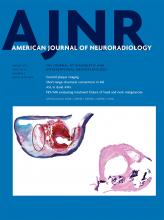The use of perfusion imaging has greatly increased during the recent decade, becoming an integral part of the acute stroke imaging protocol,1 and it is now included in recent acute stroke guidelines, recommending perfusion imaging in the late (6- to 24-hour) timeframe for intervention.2 Because the role of perfusion imaging in patient selection is increasingly widespread, obtaining high-quality and accurate acquisitions and analysis becomes of critical importance.
Most stroke centers worldwide use CTP rather than MR perfusion due to its wider availability, rapid imaging, superior vascular imaging of extracranial and distal intracranial vessels, and fewer absolute contraindications.1-3 However, CTP still has several limitations and pitfalls, precluding it from being the criterion standard for the assessment of salvageable brain tissue. These limitations include lack of standardized acquisition protocols, heterogeneity of postprocessing techniques and thresholds, inaccurate estimation of white matter lesions, and low sensitivity for the detection of lacunar infarcts.4-6
Delayed arrival of the contrast bolus or truncation (early termination) is the main cause of inadequate acquisition of CTP and is reported to occur in up to 67% of CTP scans.7,8 Truncation may result in incomplete capture of the tissue time-attenuation curves and thus precludes accurate estimation of the infarct core and penumbra. Previous studies have found truncation to falsely repartition the ROI into a larger ischemic core and smaller penumbra volumes.8 Delayed contrast arrival and early termination frequently result from the susceptibility of CTP to the influence of impaired cardiac output or flow-limiting carotid artery stenosis.4,9 Because the 2 leading etiologies for large-vessel occlusion (LVO) are large-vessel atherosclerosis and atrial fibrillation, inadequate contrast-injection timing becomes a main pitfall of CTP. Truncation rates vary in accordance with the duration of CTP scan times. Although a longer scan duration of 90 seconds may reduce truncation rates many centers use 40- to 60-second protocols to reduce the radiation load and risk of patient movement.10
In this issue of the American Journal of Neuroradiology, Hartman et al11 examined the use of patient-tailored CTP acquisition protocols, a standard acquisition versus specific low cardiac output (LCO) protocol, to achieve better timing of the contrast bolus and avoid truncation.11 This novel approach is in contrast to previous studies10 that tried to define a unified optimal scan duration. In the current trial, the LCO protocol had a prolonged image-acquisition time of 75 seconds and an expanded scan delay of 7 seconds after contrast bolus injection, compared with an acquisition time of 65 seconds and a delay of 2 seconds in the standard protocol. Protocol selection was determined using test dose enhancement rise timing, routinely performed on CTA. A cutoff value of 15 seconds from contrast injection to a measure of 100 HU in the aortic arch was used. Among 157 scans obtained, truncation was demonstrated in only 2.5% versus 9.8% among 153 patients who underwent routine CTP using the standard protocol exclusively. The use of this semiautomated model allowed substantial improvement in the CTP acquisition without exposing patients to unneeded excess radiation. Most important, among patients who were found suitable for the standard acquisition duration, no cases of truncation were documented. Therefore, it seems that the proposed algorithm for protocol selection has very good sensitivity and may imply that the extension of the scan duration in the LCO protocol may reduce truncation rates even further.
The authors further examined factors that distinguish patients with high-versus-low risk for early termination. Age, a low left-ventricular ejection fraction, and the absence of hypertension were found to be independent risk factors for truncation. These factors and other previously mentioned parameters are directly associated with contrast arrival time to the intracranial vessels.4,9,11 Such clinical characteristics may also be used to detect patients with a high risk of truncation. However, the use of test dose enhancement rise timing is preferable, due to the semiautomated nature of the described protocol, which requires no preliminary clinical data nor any action from the stroke physician and thus would not lead to any delay in imaging or intervention times.
The limitations of the current study are mainly because all scans were performed in a single center with the use of a single CTP postprocessing software package. The suggested protocols should be examined using various scanners and software programs to assess the generalizability of the results. Second, a relatively high exclusion rate was observed, with 16% of patients excluded due to a lack of an echocardiogram or severe technical problems. The authors discuss these limitations, including the possibility of selection bias.
The current study emphasizes the importance of case-specific CTP acquisition protocols and brings us one step closer to improved CTP diagnostic accuracy. Further studies are needed to optimize CTP acquisition and processing protocols, examine possible needed adjustments for other specific cases including carotid occlusion, and improve CTP resolution for the detection of small, lacunar infarcts.
References
- © 2022 by American Journal of Neuroradiology







